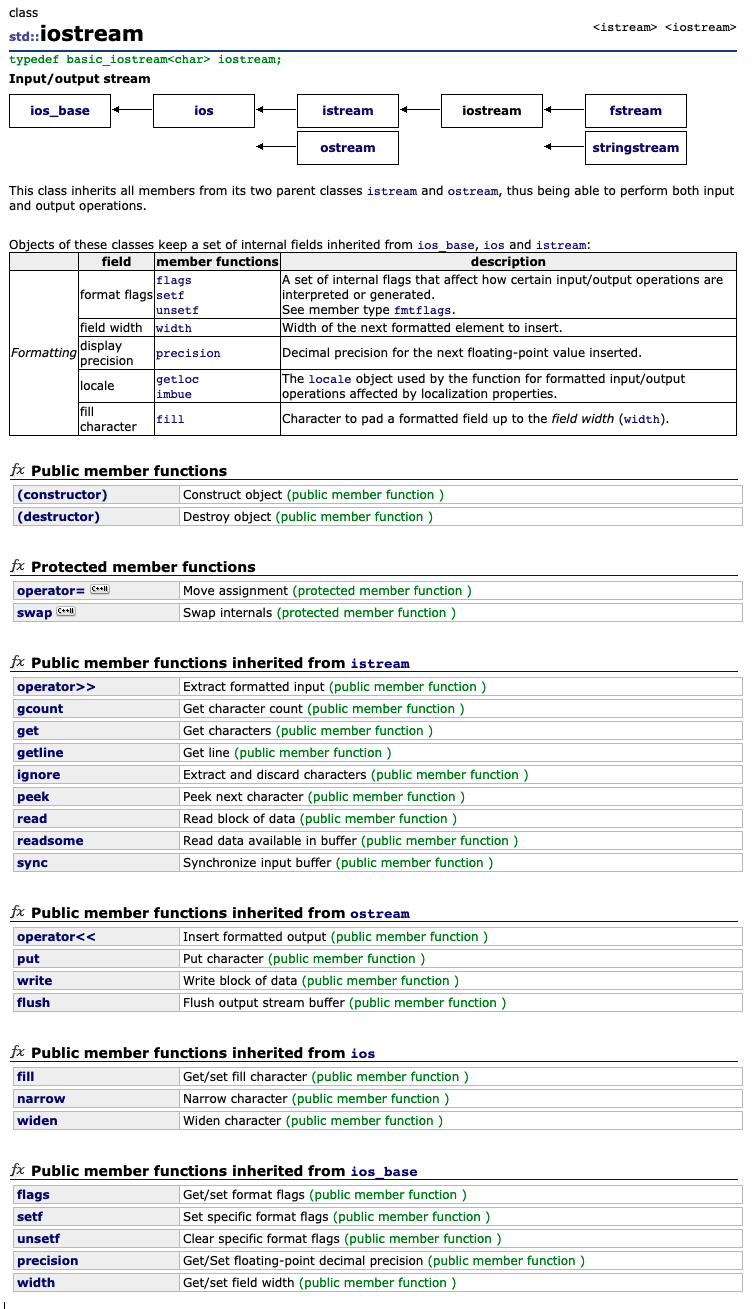C/C++ 语言系列(十一)I/O 库总结
Input/Output library
下图是 C++ 提供的输入/输出库,其中:
<xxx>表示:头文件- 白框表示:类(Classes)
- 黑框表示:对象(Objects)

The iostream library is an object-oriented library that provides input and output functionality using streams.
A stream is an abstraction that represents a device on which input and ouput operations are performed. A stream can basically be represented as a source or destination of characters of indefinite length.
Streams are generally associated to a physical source or destination of characters, like a disk file, the keyboard, or the console, so the characters gotten or written to/from our abstraction called stream are physically input/output to the physical device. For example, file streams are C++ objects to manipulate and interact with files; Once a file stream is used to open a file, any input or output operation performed on that stream is physically reflected in the file.
To operate with streams, C++ provides the standard iostream library, which contains the following elements:

Basic class templates
The base of the iostream library is the hierarchy of class templates. The class templates provide most of the functionality of the library in a type-independent fashion.
Class template instantiations
The library incorporates two standard sets of instantiations of the entire iostream class template hierarchy:
The narrow-oriented (
chartype) instantiation is probably the better known part of the iostream library. Classes likeios,istreamandofstreamare narrow-oriented. The diagram on top of this page shows the names and relationships of narrow-oriented classes.The classes of the wide-oriented (
wchar_t) instatiation follow the same naming conventions as the narrow-oriented instantiation but with the name of each class and object prefixed with awcharacter, formingwios,wistreamandwofstream, as an example.
Objects
As part of the iostream library, the header file
<iostream>declares certain objects that are used to perform input and output operations on the standard input and output.They are divided in two sets:
- narrow-oriented objects:
cin,cout,cerrandclog- wide-oriented objects:
wcin,wcout,wcerrandwclog
Manipulators
Manipulators are global functions designed to be used together with insertion (
<<) and extraction (>>) operators performed oniostreamstream objects. They generally modify properties and formatting settings of the streams.
常用头文件
下列这些头文件在 C++ 编程中很常用,下面分别介绍:
| 头文件 | 函数和描述 |
|---|---|
<iostream> |
该文件定义了 cin、cout、cerr 和 clog 对象,用于输入输出。 |
<iomanip> |
该文件通过所谓的参数化的流操纵器(比如 setw、setfill、setprecision),来声明对执行标准化 I/O 有用的服务。 |
<fstream> |
该文件定义了 ifstream、ofstream、fstream 对象,用于文件读写。 |
<iostream>
下图摘录了 iostream 类的继承关系及成员函数,如下:

http://www.cplusplus.com/doc/tutorial/basic_io/
http://www.cplusplus.com/reference/iolibrary/
output stream
输出流与流插入运算符 << 配合使用。<iostream> 提供了下列三种输出流对象:
cout标准输出流(默认设备是显示器屏幕)cerr无缓冲标准错误输出流(默认设备是显示器屏幕)clog有缓冲标准错误输出流(默认设备是打印机)
此外,<iostream> 还提供了一个常用的操纵符:
endlInsert newline and flush
例子:
1 | // 定义一些头文件,这些头文件包含了程序中必需的或有用的信息。 |
运行结果:hello world
input stream
输入流与流提取运算符 >> 配合使用。<iostream> 提供了下列一种输入流对象:
cin标准输入流(默认设备是键盘)
例子:
1 | cin >> name; |
<iomanip> 流操纵器
常用流操纵器函数如下:
| 函数 | 作用 |
|---|---|
setw |
Set field width |
setfill |
Set fill character |
setprecision |
Set decimal precision |
| … |
setw 函数用于设置字段的宽度,只对紧接着的输出产生作用。当后面紧跟着的输出字段长度小于 n 的时候,在该字段前面默认用空格补齐,当输出字段长度大于 n 时,全部整体输出。如下:
例子:
1 |
|
运行结果:3.14*
参考:
https://www.runoob.com/w3cnote/cpp-func-setw.html
<fstream> 文件读写
<fstream> 定义了下面三个对象,用于文件读写:
| 数据类型 | 描述 |
|---|---|
ofstream |
该数据类型表示输出文件流,用于创建文件并向文件写入信息。 |
ifstream |
该数据类型表示输入文件流,用于从文件读取信息。 |
fstream |
该数据类型通常表示文件流,且同时具有 ofstream 和 ifstream 两种功能,这意味着它可以创建文件,向文件写入信息,从文件读取信息。 |
例子:
1 |
|
参考:
